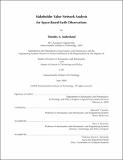| dc.contributor.advisor | Edward F. Crawley. | en_US |
| dc.contributor.author | Sutherland, Timothy A. (Timothy Alan) | en_US |
| dc.contributor.other | Massachusetts Institute of Technology. Technology and Policy Program. | en_US |
| dc.date.accessioned | 2011-06-06T14:11:04Z | |
| dc.date.available | 2011-06-06T14:11:04Z | |
| dc.date.copyright | 2009 | en_US |
| dc.date.issued | 2009 | en_US |
| dc.identifier.uri | http://hdl.handle.net/1721.1/63181 | |
| dc.description | Thesis (S.M.)--Massachusetts Institute of Technology, Dept. of Aeronautics and Astronautics; and, (S.M. in Technology and Policy)--Massachusetts Institute of Technology, Engineering Systems Division, Technology and Policy Program, 2009. | en_US |
| dc.description | This electronic version was submitted by the student author. The certified thesis is available in the Institute Archives and Special Collections. | en_US |
| dc.description | Cataloged from student-submitted PDF version of thesis. | en_US |
| dc.description | Includes bibliographical references (p. 237-238). | en_US |
| dc.description.abstract | The Earth Science and Applications decadal survey released by the National Research Council in 2007 presents both an ambitious engineering challenge and a challenge for the entire Earth science community to come together to reach a consensus on priorities that cross conventional disciplinary boundaries. The vision established by the decadal survey requires a paradigm shift for Earth system science: Societal benefits must be considered equally with purely scientific benefits to guide the development of the future NASA and NOAA Earth Observations Program. The decadal survey focused heavily on the needs and objectives of the Earth science community, while providing much less thorough treatment of the other relevant stakeholders. To address this, I conducted a stakeholder value network analysis for the Earth Observations Program that includes the development of a comprehensive qualitative and quantitative stakeholder model. The qualitative model includes a rigorous articulation of the needs and objectives of 13 major stakeholders; the development of a three-level stakeholder map including a baseline map, higher-level map, and lower-level map; and a complete stakeholder value network model with 190 individual value flows that capture the interactions between all the stakeholders. The quantitative model includes a method for assigning numeric scores to each value flow; the calculation of 1880 unique and valid "value loops" within the stakeholder value network; and an analysis of the value loops that yields useful insights about the Earth Observations Program. The value loop analysis reveals the most important stakeholders, value flows, and value loops within the stakeholder value network; as well as the most important outputs from and inputs to NASA and NOAA. The analysis also reveals the relative important of each of the six science categories representing the six science-themed panels of the decadal survey. The results from the stakeholder value network analysis provide insights regarding the value produced by the Earth Observations Program, as well as the value-added roles of each stakeholder within the network. The most important value loops and Program outputs are used to derive a set of high-level program goals, including goals that suggest what NASA and NOAA should do, as well as how they should conduct business. Finally, the insights and results from the analysis provide the foundation for a set of recommendations for the Earth Observations Program, which complement the recommendations put forth in the decadal survey. | en_US |
| dc.description.statementofresponsibility | by Timothy A. Sutherland. | en_US |
| dc.format.extent | 238 p. | en_US |
| dc.language.iso | eng | en_US |
| dc.publisher | Massachusetts Institute of Technology | en_US |
| dc.rights | M.I.T. theses are protected by
copyright. They may be viewed from this source for any purpose, but
reproduction or distribution in any format is prohibited without written
permission. See provided URL for inquiries about permission. | en_US |
| dc.rights.uri | http://dspace.mit.edu/handle/1721.1/7582 | en_US |
| dc.subject | Aeronautics and Astronautics. | en_US |
| dc.subject | Engineering Systems Division. | en_US |
| dc.subject | Technology and Policy Program. | en_US |
| dc.title | Stakeholder value network analysis for space-based earth observations | en_US |
| dc.type | Thesis | en_US |
| dc.description.degree | S.M.in Technology and Policy | en_US |
| dc.description.degree | S.M. | en_US |
| dc.contributor.department | Massachusetts Institute of Technology. Department of Aeronautics and Astronautics | |
| dc.contributor.department | Massachusetts Institute of Technology. Engineering Systems Division | |
| dc.contributor.department | Technology and Policy Program | |
| dc.identifier.oclc | 719579962 | en_US |
